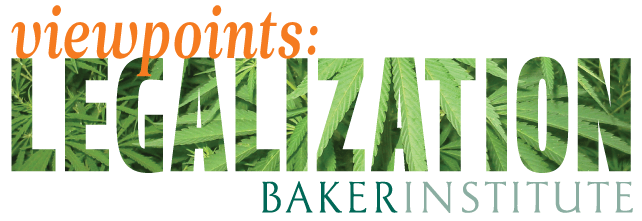
Baker Institute Viewpoints is a regular blog series that presents an array of views on a single issue. In this installment, five Baker Institute fellows and two guest experts will consider whether the United States should legalize marijuana. Each weekday from Sept. 17- Sept. 25, one of the seven writers — whose backgrounds include a biography of evangelist Billy Graham and a 30-year career in the Drug Enforcement Administration (DEA) — will give his or her take on the issue.
Today, Baker Institute nonresident drug fellow Gary Hale, former chief of intelligence in the Houston Field Division of the DEA, writes that when it comes to the legalization of marijuana, the question is when, not if.
- Read Monday’s post, “Marijuana: A case for legalization,” by William Martin, director of the Baker Institute Drug Policy Program.
- Read Tuesday’s post, “In a contest with alcohol and tobacco, marijuana wins,” by guest writer Sylvia Longmire, an author and expert on Mexico’s drug wars.
I am neither a proponent nor an opponent of the legalization of marijuana. I am, however, a pragmatist who believes that the nationwide legalization of the personal use of marijuana is inevitable. While it has inherent risks associated with prolonged use, the American public is consistently leaning toward the legalization of personal use of marijuana, much as the public’s continued use of alcohol resulted in the repeal of Prohibition. As another case in point, people continue to smoke tobacco at great personal risk to their health.
As a pragmatist, I believe that we should continue to discuss the issue and prepare for the eventuality of legalization. Legalization of marijuana use has numerous legal, economic and social implications that have not been sufficiently addressed. Some of those implications are legal (criminal) in nature and beg a number of questions, including the reaction of the states and how they will legislate punishment for anyone who is found to be “driving under the influence of marijuana.” Will the penalties equate to driving under the influence of alcohol? Given that marijuana is considered a hallucinogen, how will the definition of “impairment” differ from driving under the influence of alcohol (itself considered a depressant)? It stands to reason that THC content could be measured in the body; however, that may prove to be an intrusive violation of individual rights, especially given that most measures that exist currently are qualitative, not quantitative.
A separate set of legal (civil) questions arise that also need attention. For example, what will the civil courts do when confronted with a civil suit for wrongful death caused by a marijuana-intoxicated person who caused the wrongful death of another? How will the civil courts decide branding rights? How will it be decided to whom the brand “Acapulco Gold” belongs? To whom does the brand “B.C. Bud” belong?
Economic concerns may impact the U.S. trade relationship with other nations. How, for instance, will the United States, Mexico, Colombia, Jamaica and other nations decide on importation and exportation laws for marijuana? Will the United States and other nations include marijuana as a vegetable, drug or other substance when considering its importation or exportation? Will the U.S. and other nations engage in trade wars, such as those under the NAFTA treaty, wherein U.S. farmers alleged that Mexican farmers “dumped” tomatoes, avocadoes and other produce into the U.S. market, to the detriment of the U.S. farmer?
Social considerations will also emerge and will have to be addressed. How will we discuss marijuana use in the social environment? Will schools teach about the detriments to the human body in school health classes? Will those who provide marijuana to underage youths be subject to the same penalties as those who provide alcohol to a minor, or will the punishment be more harsh, given its designation as a hallucinogen.
More questions: Will governments be faced with having to pay “reparations” to the families of police officers and federal agents who died while working to destroy marijuana plantations in the United States and abroad? For example, will the torture and death of DEA agent Enrique “Kiki” Camarena, and the torture of DEA agent Victor Cortez, both in Mexico, as well as the shooting of DEA agent Kelly McCullough in Colombia, have been in vain? After all, Camarena was killed for discovering and being responsible for the destruction of the largest marijuana plantation ever discovered in Mexico (the so-called “Buffalo” plantation) up to that time (mid-1980s). Two DEA special agents were shot for conducting over flights and taking photos of “motherships” while they were being loaded in the Guajira Peninsula of Colombia. What do we say to these men who answered the call of the U.S. government to suppress the supply-side of the marijuana ?
The financial costs of transitioning to a marijuana permissive society will be high and will include the expense of new legislative, criminal, civil, educational, social and security changes. Substantial thought will have to be given to how the U.S. government will recover those costs. Will it require an increase in taxes or the creation of a marijuana tax? The tax-weary American public may not willingly sustain another “sin” tax, like that applied to tobacco and, in some places, alcohol.
I propose that model policies be developed in these areas in anticipation of legalization. I recommend that such model policies be published for use by legislators for when the legalization moment arrives and that way, be ahead of the legislative curve. As a pragmatist, I make these recommendations because I believe that marijuana legalization is not a question “if,” but “when.”
 Gary J. Hale is the nonresident fellow in drug policy at the Baker Institute. From 2000 to 2010, he was chief of intelligence in the Houston Field Division of the Drug Enforcement Administration. From 1990 to 1997, Hale had various assignments in Washington, D.C., including serving as chief of the Heroin Investigations Support Unit, chief of the Dangerous Drugs Intelligence Unit and liaison to the National Security Agency. During this period, he also served a tour of duty at the U.S. Embassy in Bogotá, Colombia. From 1997 to 1998, Hale was assigned as the DEA intelligence chief at the U.S. Embassy in Mexico City.
Gary J. Hale is the nonresident fellow in drug policy at the Baker Institute. From 2000 to 2010, he was chief of intelligence in the Houston Field Division of the Drug Enforcement Administration. From 1990 to 1997, Hale had various assignments in Washington, D.C., including serving as chief of the Heroin Investigations Support Unit, chief of the Dangerous Drugs Intelligence Unit and liaison to the National Security Agency. During this period, he also served a tour of duty at the U.S. Embassy in Bogotá, Colombia. From 1997 to 1998, Hale was assigned as the DEA intelligence chief at the U.S. Embassy in Mexico City.